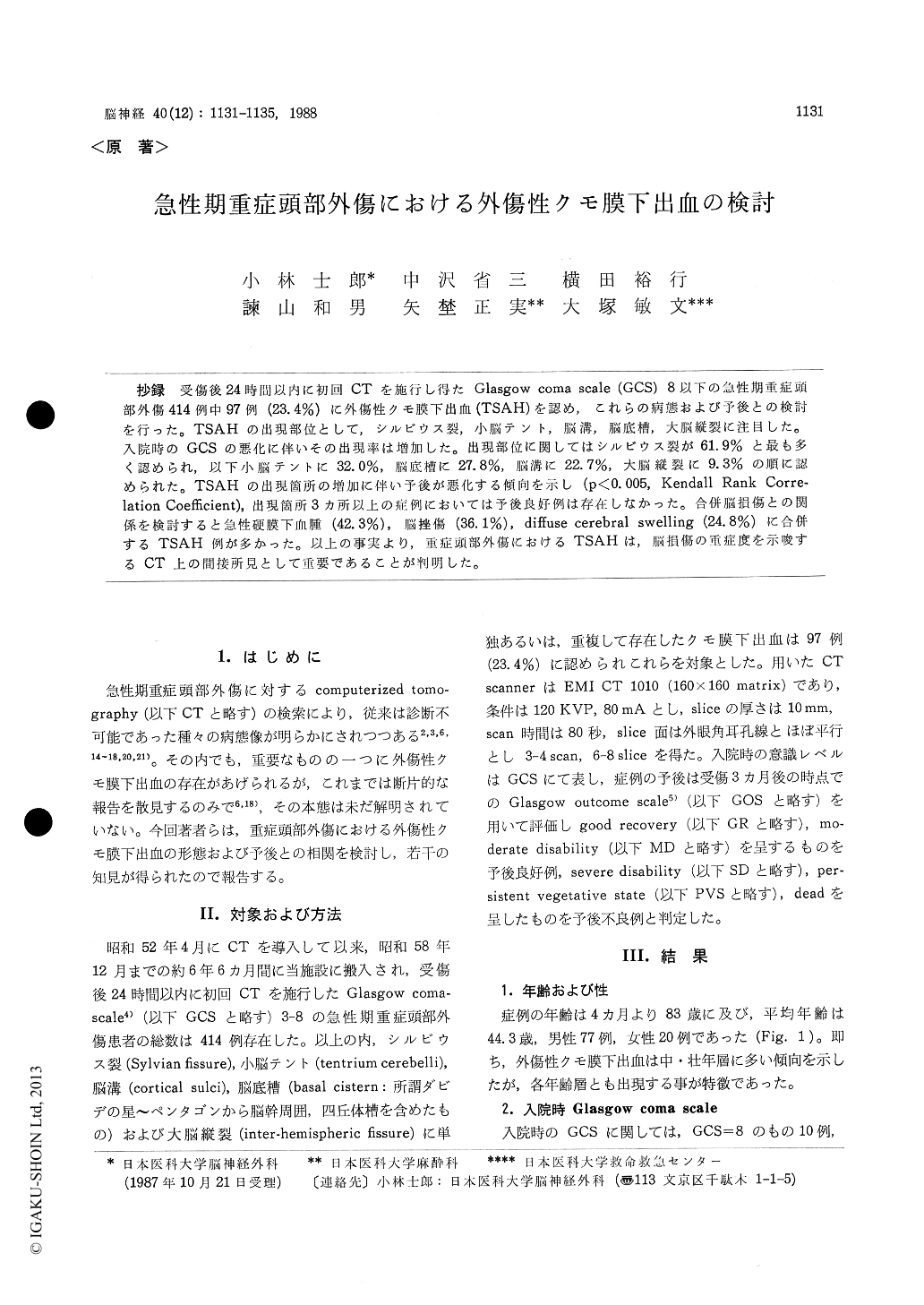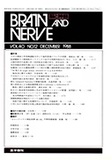Japanese
English
- 有料閲覧
- Abstract 文献概要
- 1ページ目 Look Inside
抄録 受傷後24時間以内に初回CTを施行し得たGlasgow coma scale (GCS)8以下の急性期重症頭部外傷414例中97例(23.4%)に外傷性クモ膜下出血(TSAH)を認め,これらの病態および予後との検討を行った。TSAHの出現部位として,シルビウス裂,小脳テント,脳溝,脳底槽,大脳縦裂に注目した。入院時のGCSの悪化に伴いその出現率は増加した。出現部位に関してはシルビウス裂が61.9%と最も多く認められ,以下小脳テントに32.0%,脳底槽に27.8%,脳溝に22.7%,大脳縦裂に9.3%の順に認められた。TSAHの出現箇所の増加に伴い予後が悪化する傾向を示し(P<0.005, Kendall Rank Corre-lation Coefficient),出現箇所3カ所以上の症例においては予後良好例は存在しなかった。合併脳損傷との関係を検討すると急性硬膜下血腫(42.3%),脳挫傷(36.1%),diffuse cerebral swelling (24.8%)に合併するTSAH例が多かった。以上の事実より,重症頭部外傷におけるTSAHは,脳損傷の電症度を示唆するCT上の間接所見として重要であることが判明した。
Traumatic subarachnoid hemorrhage (TSAH) is a frequent occurence resulting from acute severe head injury. Computerized tomography (CT) accu-rately identifies the region, extent and nature of TSAH following trauma. But, to our knowledge, there have been few series detailing the charac-teristics of TSAH in acute severe head injury. The purpose of this study is to describe the findings, nature and prognosis of TSAH.
Over a six and a half year period between April 1977 and September 1983, 414 severely head injured patients were examined by CT within 24 hours of the injury in the Department of Neurological Surgery and Critical Care Medi-cine, Nippon Medical School. Among them, 97 (23.4%) patients showed the appearance of TSAH in the Sylvian fissures, tentorium cerebelli, cor-tical sulci, basal cisterns and interhemispheric fissures. Conscious state on admission was defined using the Glasgow Coma Scale (GCS) and clinical outcome was defined using Glasgow Outcome Scale. There were 77 men and 20 women, ran-ging from 4 months to 83 years in age (means 44.3 years). TSAH therefore appears to be seen in all age groups, but especially in middle age groups. The GCS on admission was 8 or less in all cases ; the GCS was 8 in 10 cases, 7 in 7 cases, 6 in 15 cases, 5 in 16 cases, 4 in 23 cases, 3 in 26 cases. The lower GCS scores, the more frequently TSAH was identified, and 67% of the patients had a GCS of 6 or less. The distribution of TSAH by CT were as follows : 61.9% in the Sylvian fissures, 32% along the tentorium cerebelli, 27.8% in the basal cisterns, 22.7% in cortical sulci and 9. 3% in the interhemispheric fissures (n=97). Patients with isolated TSAH in the Sylvian fissures or along the tentorium cerebelli had a relatively good outcome ; on the other hand the patients presenting TSAH in the basal cisterns demonstrated a poor outcome. The wider the distribution of the TSAH, the worse the utcome (p<0.005 by the Kendall Rank Correla-tion Coefficient). Among those patients having TSAH in the three of the regions, there were no good outcomes. Associated CT findings most commonly were acute subdural hematoma (41.3%), cerebral contusion (37.6%) and diffuse cerebral swelling (23.7%). Concerning the Glasgow Out-come Scale of TSAH at three months after trauma, good recovery occurred in 12 cases (12.4%), mo-derate disability in 9 cases (9.3%), and severe disability was 7 cases (7.2%), persistent vegeta-tive state was 14 cases (14.4%) and dead was 55 cases (56.7%).
We conclude that TSAH in acute severe head injury appears to be an important risk factor indicating poor prognosis.

Copyright © 1988, Igaku-Shoin Ltd. All rights reserved.


